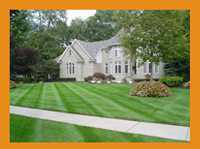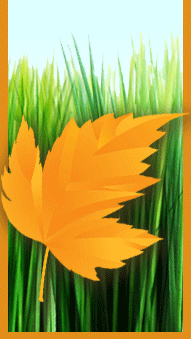| |
Watering
Watering is the most underestimated factor of lawn maintenance. Water contributes to the health, strength and color of the turf potentially more than any other factor. And with a simple watering technique, it will make the world of difference: Water longer, less often! The roots of your grass will only go as deep as the water penetrates. This is why watering for a longer period of time is beneficial vs. a shorter period; the water penetrates deeper into the soil. Roots should be 6 inches deep for the grass to be resistant to the wear and tear it will receive from weather and traffic. Here are a few tips when watering: |
| |
Water once to twice a week. Remember, your lawn only needs 1-2 inches of water each week. Make a one inch mark on the inside of a can and water your lawn until it reaches the mark. Doing this twice a week will be sufficient in meeting the water needs of your lawn. Be sure that all areas of the lawn receive 1-2 inches of water each week.
Water in the morning. This prevents too much evaporation during the heat of the day,
which will cause water to be wasted and not penetrate the soil. On the other hand, watering at night leaves moisture on the grass and in the soil for too long due to lack of evaporation, potentially leading to mildew or turf disease. The best practice is to water in the morning. This allows the water to penetrate the soil without drying up.
Watering too little will cause your grass roots to be weak, making it harder to sustain the grass during the heat of summer and from normal wear and tear. This can result in your grass turning a brown hay like color and will be a nice invitation for weeds to move in. But, watering too much can lead to turf diseases such as ring spot and mildew.
|
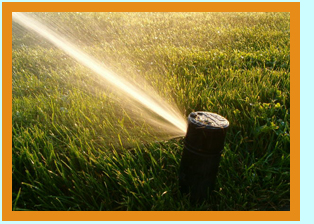 |
| |
Fertilizer and Herbicide
Fertilizing 3-5 times per year is a good practice in order to maintain a healthy, green turf. The nitrogen, phosphorus and potassium contained in fertilizers aid in the color, root depth, strength, and disease resistance of the grass. Fertilized lawns are thicker and greener. A thicker lawn crowds out unwanted pests such as dandelions or thistle, and keeps them from moving in as easily; generally weeds develop in the weaker parts of your lawn. The vegetation in a lawn is constantly battling over the water and nutrients in the soil, and because weeds are more tolerant to drought, your grass could lose the battle if it's not strengthened by effectively fertilizing and watering. |
| |
Herbicides are for killing unwanted vegetation, as opposed to fertilizer which strengthens the vegetation we want to keep. The herbicides used on your lawn are called "selective" herbicides, because only the desired vegetation is affected, i.e., the weeds. Other herbicides, such as Round Up, are "non-selective" herbicides, because any vegetation it comes in contact with will be affected.
Over the course of the summer, herbicides should be needed less and less as the weeds die from previous herbicide applications, as the grass is strengthened from the previous fertilizer applications, and as proper watering techniques are observed. Keep in mind, it is almost impossible to rid your lawn of every last weed, but maintaining a fertilizer and herbicide schedule will dramatically improve the health and appearance of your lawn and will greatly reduce unwanted weeds |
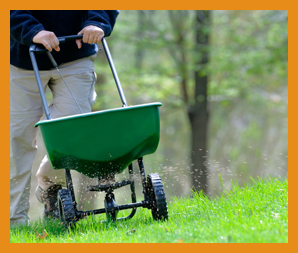 |
| |
Mowing
nother very important aspect in maintaining a healthy and beautiful lawn is to mow it properly. Mowing seems simple, and it is, but remember that grass isn't like our hair; for most types of grass, we can't cut it as short as we want and have it grow back the same. Longer is better. Follow these steps to improve the condition of your lawn:
|
| |
Cut off up to 1/3. It's important to cut your lawn the proper height. Not every grass type can be cut the height we would like to see. Cutting too much of the grass blade off will damage the part of the blade needed for photosynthesis - what makes the grass grow. Unless you know you have a golf green type grass, maybe Kentucky Bluegrass, than you probably have a type of fescue. Fescue's should be kept at a height of 2 - 3 inches (6-8 cm). So once your grass blades reach a height of 3 inches, cut 1 inch (or 1/3) of the grass blades off, bringing them to a height of 2 inches. That is the best rule of thumb!
Reduce Stress. Mowing your lawn actually stresses your lawn. Cutting grass isn't a natural occurrence. To reduce stress as much as possible: Keep your blades sharp. This will cause the grass to be cut off instead of torn off, which will also keep the tips of the grass blades from turning brown.Change the mowing direction. The wheels on the mower cause stress to the turf, and when riding over the same wheel track every week for several months, the lawn can become damaged and compacted. In extreme cases, when a lawn is very weak, the grass under the wheels of the mower will actually die and turn brown, leaving dead stripes across your entire lawn, which you won't notice until days later! By switching the cutting path to be opposite of the previous weeks', the grass under the wheel has time to recover before mowing in the same direction again. Doing this right will also give your lawn a nice checkerboard pattern!
|
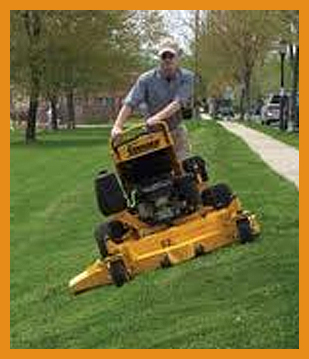 |
| |
Aeration
Core aerating is the process of removing plugs from your lawn and leaving them on the surface to decompose back into your yard. This process has a number of benefits:The problem with compaction is that water is unable to penetrate the soil, and therefore runs off of it. This not only keeps your lawn from receiving the nutrients from the water, but water is wasted as it runs off the surface or dries up from the sun. We recommend aerating your lawn at least once a year. Along with letting water into the soil, it lets oxygen and other nutrients in as well. One of the greatest benefits of aeration is the strength your lawn receives. With added oxygen, water, and nutrients, additional grass blades start to grow, existing roots grow deeper, and your lawn becomes more resistant to drought and normal wear and tear.
|
| |
Aerating your lawn also serves as a minor de-thatcher. The plugs pull up thatch and dirt that is later broken down and decomposed, releasing further nutrients in your lawn. It is therefore good to leave these plugs on your lawn; they will usually break down within a week or two with normal watering and mowing. Aeration should be done during the high growing season, either spring or fall, when the lawn is the strongest. If done during the middle of summer, the stress caused from the aeration could damage your lawn. If done in the spring or fall, your lawn will manage just fine. *Note, aerating to soon in the spring when the temperature dips below freezing at night is also harmful. Your grass roots are now exposed and the freezing temperature or frost can cause severe damage to your lawn. Monitor the temperature and be sure it won't go below zero during the night before you aerate.
The benefits of aeration are significant and visible, this is why it is one of the most recommended lawn care practices. |
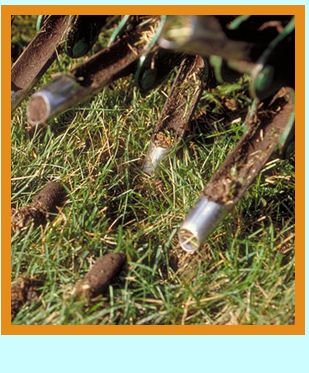 |
| |
Power Raking (De-thatch)
Power Raking is the process of removing the built up organic matter that sits on the top of the soil of your lawn. It is important to note though, that some thatch is healthy, and actually needed, for a healthy lawn. Thatch serves some purpose in shielding the grass crowns and roots from the sun. Without some thatch, your yard will dry out and burn. After you power rake, if you can easily see the soil by looking down on your lawn, or the marks from the power rake in the soil, you may need to remove less thatch the next time you power rake. On the other hand, too much thatch has a choking effect on the grass, and shields it from the sun and other important nutrients. It also creates a nice environment for turf disease and other potential pests. |
| |
De-thatching is only necessary when you have 1/2 inch or more of thatch build up. To find out how thick your thatch layer is, cut out a small piece of your lawn with a shovel and measure the thatch layer between the top of the soil and the highest point of thatch. Having a 1/2 inch of thatch is healthy for most yards.
Power raking, like aerating, should be done during the high growing season, either spring or fall, when the lawn is the strongest. If done during the slow growing season, the stress caused from de-thatching could further damage your lawn. If done in the spring or fall, your lawn will manage just fine. |
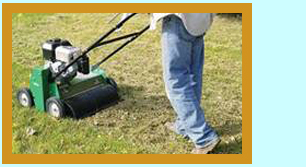 |
| |
Pet Waste
Tired of you pet causing brown spots on your lawn? Here's a few tips:
|
 |
Did you know, the brown spot occurs because your pets' feces act as a fertilizer, a highly concentrated one! Their feces contain high levels of nitrogen and phosphorus, which when applied on your lawn causes it to burn. If you applied too much lawn fertilizer to your yard, this would also happen. Remove pet waste as soon as possible to keep your grass from burning.
To help avoid burning after your pet urinates, try pouring water on the area to dilute the urine on the grass.
.
|
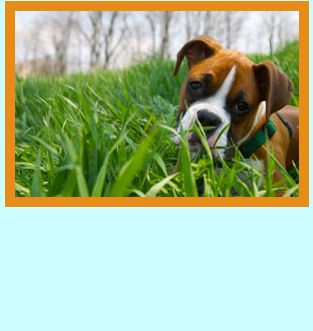 |


